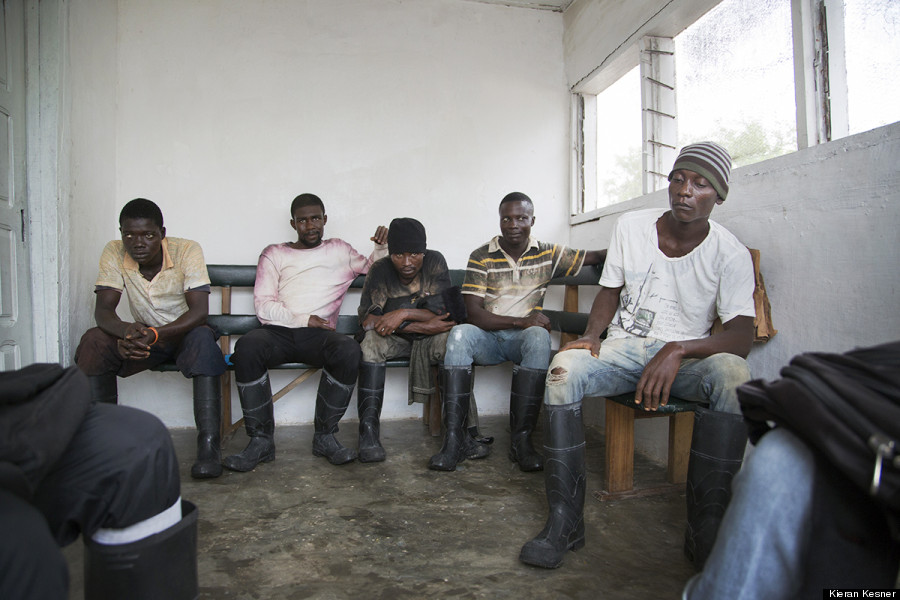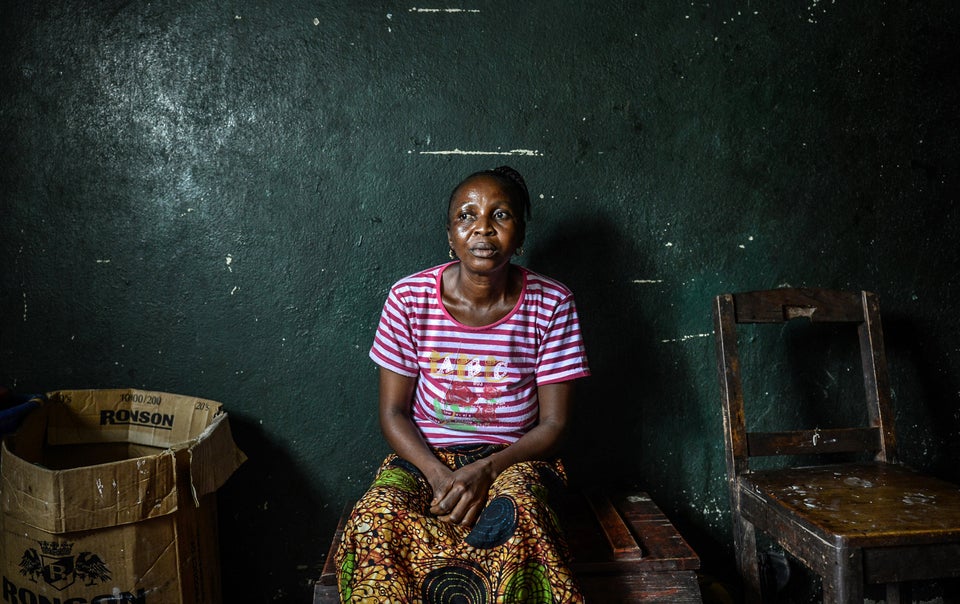Kieran Kesner is a photographer who was in Liberia documenting the Ebola outbreak from Aug. 27 to Sept. 4. During his time there, he was able to shadow an Ebola burial team in Unification Town, Liberia. "This is most certainly not desired work but these men, like many others, are forced to work daily in life-threatening situations in an effort to contain the Ebola outbreak," Kesner told The Huffington Post. "These men firmly believe that they have a responsibility to do this work to protect their family, loved ones and greater country." Kesner shared some of his images with HuffPost and also explained what he learned about what it's like to be in this line of work during the world's worst Ebola outbreak. For all of Kesner's images, visit his website.
Editor's Note: Some readers may find the following images disturbing.

The men sitting on this bench are all members of the burial team in Unification Town, Liberia. I had arranged to visit with them on Aug. 30 to understand the story behind the masks of the men in charge of both removing and burying bodies killed by Ebola. They were all sitting on the bench waiting for a body bag to be delivered, an essential piece of equipment, which, at the time, was in severe shortage in Liberia.

Members of the Ebola burial team push-start their car to go pick up a body. In the trunk of the car is chlorine spray and other PPE [personal protective equipment]. This car is used to transport the team, their PPE and their equipment. However, the empty minivan they used to transport the bodies also needed to be jump-started before going to pick up the body.

This is the standard PPE I saw the burial team utilize. The minimum gear to function at their job includes full-body suits, latex gloves, rubber gloves, face mask, rubber boots, goggles, a second protective hood under the suit and an apron. All open seams, like where the suit meets the gloves, are sealed with duct tape. The team is not cleared to retrieve Ebola-infected bodies if even a single piece of this equipment is missing.

An Ebola body-removal team member sprays the doorknob with a heavy concentrate of chlorine before entering to remove the body of a woman killed by Ebola. At this point in Liberia, every case is treated with the same precautions. Although Ebola had not yet been confirmed at this point in time, this woman clearly died of Ebola-related symptoms and was the fifth member of her church to die that week. The standard procedure for entering a building with Ebola is for one person to disinfect the entrance and surrounding surfaces with a highly concentrated batch of chlorine before the other members of the team enter.

This is Sis -- at least, that was what her friends at the local Pentecostal church called her. She was 46 and a mother of four. She had died the night before and was found in the morning by a relative. "She was a prayer warrior," her friend, Retta Livingstone Wahid, proudly recalled.

Shortly before entering the woman's home, my face mask had become saturated with the chlorine spray that not only made it impossible to smell, but also incredibly difficult to breathe. I remember walking into the room and it being incredibly dark. My eyes had not yet adjusted and my goggles had become severely fogged over. I was fearful I would trip over the body, so I shuffled my feet along the floor.
The scene pictured is a standard procedure. First, the team opened the body bag and placed it on the floor. They then sprayed the bag, the woman's body and the surrounding area with chlorine. The woman's body was then lifted by her hands and feet and lowered into the bag. It was then zipped shut, sprayed again and carried outside to the body-removal van.

After placing the body in the van, the burial team began the intricate process of removing the contaminated PPE. Remove a single piece in the wrong order and you risk exposing yourself to the virus. By the time we were finished undressing from our PPE, we were soaked in chlorine and spent the next 15 minutes coughing up the disinfectant.

There are varying levels of PPE. For instance, the white suits they are using here are Tyvek, a slightly permeable suit and not nearly as protective as the more expensive, yellow, Tychem. The region is dealing with a severe shortage of proper equipment to combat this Ebola outbreak. I visited a health care facility that was forced to shut down because it didn't even have latex gloves, despite being located by one of the world's largest rubber plantations.

After removing the woman's body from her home, the team drove to a nearby grave site that was made in a recently cleared section of the forest. Here, they carry the body bag toward the hole in the ground that was dug earlier that morning. All PPE, besides the rubber boots and thick rubber gloves, are only a one-time use. The gear is then either buried or burned. When carrying the woman's body to the grave, they had to redress in new protective equipment, although they said that full PPE was not required since the body had already been disinfected.

Nothing is common and nothing is standard since the outbreak of Ebola in West Africa earlier this year. This burial team is in a relatively remote part of Liberia so they were not only in charge of retrieving the body, but responsible for burying it as well. In more urban parts of the country like Monrovia, it is now standard practice to burn the bodies.
This interview has been edited for length and clarity. Additional research by Damon Dahlen.
This story is part of "Inside an Outbreak," a HuffPost series taking you to the front lines of the world's worst Ebola outbreak. For more information on how you can help, visit HuffPost Impact.
More from the series:
These Photos Reveal The Grim Reality Of Ebola In Sierra Leone
Experiences From 7 CDC Workers At The Front Lines Of The Ebola Crisis
'Ebola Is A Shadow, An Inescapable Shadow -- And It Doesn't Seem To Move'
Ebola In Sierra Leone: 'It Reminded Me Of A Conflict Zone'
Ebola In Liberia: 'It'll Get Worse Before It Gets Better. And The Worse It Gets, The Harder It Becomes.'
The Heartbreaking, Uncensored Reality Of Covering Ebola As A Journalist
What It's Like To Be An Ebola Survivor In Sierra Leone
